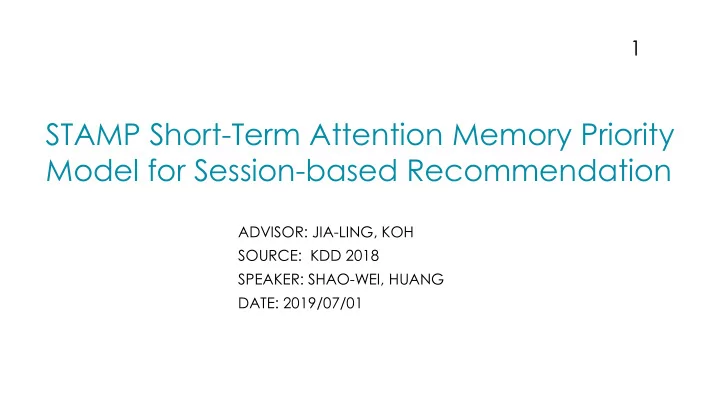

1 STAMP Short-Term Attention Memory Priority Model for Session-based Recommendation ADVISOR: JIA-LING, KOH SOURCE: KDD 2018 SPEAKER: SHAO-WEI, HUANG DATE: 2019/07/01
2 OUTLINE ⚫ Introduction ⚫ Method ⚫ Experiment ⚫ Conclusion
INTRODUCTION 3 A session ➢ What is a session? A user open A user close a broswer. a broswer. Short term memory Long term memory (Last click)
INTRODUCTION 4 ➢ What is session-based recommendation? ⚫ Predict user’s next action (click on an item) in the current session. Predict user’s next click item Output : a socre Input : user’s clicks in a session (the probability of an item)
5 INTRODUCTION Defects of traditional session-based recommendation ➢ Only consider Long term memory, without explicitly taking into account that users’ interests drift with time. STAMP Short-Term Attention/Memory Priority
6 OUTLINE Introduction Method Experiment Conclusion
7 METHOD Short-Term Memory priority(STMP) ➢ Input : ⚫ 𝑛 𝑡 denotes the user’s general interest. ⚫ 𝑛 𝑢 denotes the user’s current interest. 𝑛 𝑢 = 𝑦 𝑢 A session • 𝑦 𝑗 : 𝑓𝑛𝑐𝑓𝑒𝑒𝑗𝑜 𝑤𝑓𝑑𝑢𝑝𝑠𝑡 𝑝𝑔 𝑢ℎ𝑓 𝑗𝑢𝑓𝑛 𝑗 (d-dimensional)
8 METHOD Short-Term Memory priority(STMP) candidate ➢ MLP layer : ⚫ A simple MLP without hidden layer is used for feature abstraction. ⚫ ℎ 𝑡 = 𝑔 𝑋 𝑡 𝑛 𝑡 + 𝑐 𝑡 d*d d*1 d*1 ℎ 𝑢 = 𝑔 𝑋 𝑢 𝑛 𝑢 + 𝑐 𝑢 • 𝑔 · 𝑗𝑡 𝑏 𝑜𝑝𝑜 − 𝑚𝑗𝑜𝑓𝑏𝑠 d*1 d*d d*1 𝑏𝑑𝑢𝑗𝑤𝑏𝑢𝑗𝑝𝑜 𝑔𝑣𝑜𝑑𝑢𝑗𝑝𝑜 (𝑢𝑏𝑜ℎ)
9 METHOD Short-Term Memory priority(STMP) candidate ➢ Predict score : ⚫ Calculate the trilinear product of the candidate i. < ℎ 𝑡 , ℎ 𝑢 , 𝑦 𝑗 > = σ 𝑙=1 𝑒 ℎ 𝑡𝑙 ℎ 𝑢𝑙 𝑦 𝑗𝑙 ⚫ Use softmax function to obtain • 𝑦 𝑗 : 𝑓𝑛𝑐𝑓𝑒𝑒𝑗𝑜 𝑤𝑓𝑑𝑢𝑝𝑠𝑡 𝑝𝑔 probability distribution of items. 𝑢ℎ𝑓 𝑗𝑢𝑓𝑛 𝑗 (d-dimensional) • σ : sigmoid function
10 METHOD Short-Term Memory priority(STMP) candidate ➢ Loss function : the ground truth ⚫ Cross entropy the ground truth • |V| : 𝐷𝑏𝑜𝑒𝑗𝑏𝑒𝑏𝑢𝑓 item dictionary
11 METHOD Short-Term Attention Memory priority(STAMP) candidate ➢ Add attention net into STMP : ⚫ Generate attent weights ⚫ Compose attent weights 𝑦 𝑗 • 𝑦 𝑗 : 𝑓𝑛𝑐𝑓𝑒𝑒𝑗𝑜 𝑤𝑓𝑑𝑢𝑝𝑠𝑡 𝑝𝑔 𝑢ℎ𝑓 𝑗𝑢𝑓𝑛 𝑗 (d-dimensional) • σ : sigmoid function
12 OUTLINE Introduction Method Experiment Conclusion
13 EXPERIMENT Dataset ➢ Yoochoose: • Consists of six months of click-streams gathered from an e- commerce web. • 7,966,257 sessions of 31,637,239 clicks on 37,483 items. ➢ Diginetna: • Also consists click-streams gathered from an e-commerce web. • 202,633 sessions of 982,961 clicks on 43,097 items.
EXPERIMENT 14 ➢ Evaluation metrics • N : 測次資料的總比數 • 𝑜 ℎ𝑗𝑢 :正確答案有被排在預測出來 ranking list 前 K 名的筆數 。 • Rank(t) : 正確答案被排在 ranking list 的第幾名。 •
15 EXPERIMENT ➢ Next-click prediction on 3 benchmark data sets Not neural model Neural model
16 EXPERIMENT ➢ Compare STAMP with NARM
17 EXPERIMENT • − : 𝑜𝑝𝑢 𝑣𝑡𝑓 𝑚𝑏𝑡𝑢 𝑑𝑚𝑗𝑑𝑙 𝑗𝑢𝑓𝑛 𝑓𝑛𝑐𝑓𝑒𝑒𝑗𝑜 𝑗𝑜 𝑢ℎ𝑓 𝑢𝑠𝑗𝑚𝑗𝑜𝑓𝑏𝑠 𝑚𝑏𝑧𝑓𝑠. ➢ Effects of the last click
18 EXPERIMENT ➢ Effects of the last click on Yoochoose 1/64
19 EXPERIMENT ➢ Effects of the last click on Yoochoose 1/64
EXPERIMENT 20 • Short : sessions length <=5. ➢ Comparison among proposed models • Long : sessions length >5. on Yoochoose Short is better than Long on Diginetica Long is better than Short
EXPERIMENT 21 ➢ Comparison among proposed models Short Long **Repeated clicks ratio have an inversely proportional ratio to model performance • on Yoochoose → Short is better than Long • on Diginetica → Long is better than short
EXPERIMENT 22 ➢ Further Investigation ( Attention ) Categort of an ID Session ID
23 OUTLINE Introduction Method Experiment Conclusion
24 CONCLUSION ➢ Propose a short-term attention/memory priority model for session- based recommendations. ➢ The next move of a user is mostly affected by the last-click of a session prefix, and our model can effectively utilize such information through the temporal interests representation. ➢ The proposed attention mechanism can effectively capture long- term and short-term interests of a session.
Recommend
More recommend